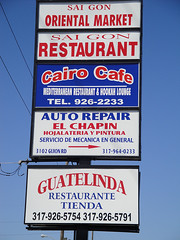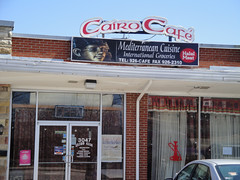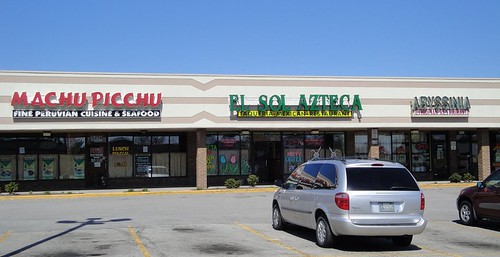How immigrants are revitalizing America’s fading suburbs

Posted April 23, 2010 at 1:30PM
The Urbanophile, Aaron Renn, has an interesting new post about how American suburbs, particularly inner-ring suburbs, are being revitalized by immigrant populations.  His focus is on his home region of Indianapolis, but the photos he presents and the stories he recounts could just as easily be set in Wheaton, Rockville or Annandale near my own home turf of Washington, DC.
His focus is on his home region of Indianapolis, but the photos he presents and the stories he recounts could just as easily be set in Wheaton, Rockville or Annandale near my own home turf of Washington, DC.
Aaron’s photo-essay suggests that, although the types of suburban retrofits urged by new urbanist thinkers such as June Williamson, Ellen Dunham-Jones and Galina Tahchieva would in many cases be appropriately holistic and elegant, they are also hard to establish and fund. As a result, what is happening in many vulnerable suburban communities, instead, is a sort of organic economic revitalization driven by immigrant communities, establishing new, often thriving small businesses (as well as residential communities) within the existing suburban fabric.
Aaron explains:
“Indianapolis was traditionally one of America’s least diverse cities, featuring only the classic black-white split. But it has seen a large influx of immigrants in the last decade. Its metro foreign born population is only 5.19%, which is small, but the Indianapolis Star reported last year that this represented a 70% population increase since 2000. Unlike some towns which have seen immigration driven almost entirely from Mexico, Indianapolis has seen a very diverse set of immigrants, that come from all over the globe, including 26,000 Asians and 10,500 Africans. The Indian population has doubled to 6,000, the Pakistani and Nigerian populations have tripled to 1,000 each. There are 5,600 Chinese and 1,500 Burmese. These aren’t huge numbers today, but given the network effects of international immigration and the lead time to build a large community (remember the example of the large community from Tala, Mexico, which has its roots in the 1970s), this represents a potential future tsunami of immigration, provided the economy stays strong, the local climate welcoming, and a bit of pro-active marketing takes place. Again, I’m sure we’d see similar diversity of immigrants in other cities, ranging from Detroit’s Arab community to Bosnians in St. Louis to Somalis in Columbus, Ohio.
“The most diverse area in Indianapolis is Pike Township on the northwest side. Though technically part of the city today, it is originally an inner ring suburban area. Its schools have children from 63 different countries speaking 74 different languages. The Lafayette Square area on the southeast boundary of Pike Township is a classic struggling inner ring commercial zone, complete with a dying mall.
“Yet the presence of all of those immigrants has led to a spontaneous renewal of parts of this struggling area in the form of businesses catering to local ethnic populations . . .”
This definitely rings true for the DC area, and I can’t help but wonder how many other regions it also fairly characterizes. To the extent it does, I think an immigrant-driven resurgence may represent the latest flowering of a longstanding American tradition, one that is really at the heart of our country’s identity and of the American Dream, using enterprise to make a better life and community here.
 I can’t say that it is a tradition that was close to me in my formative years. I did grow up in a community that was religiously diverse for a southern town: although raised as a Protestant, I went to a Catholic grade school, my mother worked for a Jewish-owned company, and my high school friends were very mixed. I’m also part Cherokee and have always been proud of it. And, of course, we had the usual black/white racial divide that unfortunately was typical of much of America at the time. But we had very little of the ethnic diversity or identity that friends who grew up in, say, New York, Chicago, Philadelphia or the Southwest had. My forebears were just too far removed from their ancestry to identify as anything but American and Southern.
I can’t say that it is a tradition that was close to me in my formative years. I did grow up in a community that was religiously diverse for a southern town: although raised as a Protestant, I went to a Catholic grade school, my mother worked for a Jewish-owned company, and my high school friends were very mixed. I’m also part Cherokee and have always been proud of it. And, of course, we had the usual black/white racial divide that unfortunately was typical of much of America at the time. But we had very little of the ethnic diversity or identity that friends who grew up in, say, New York, Chicago, Philadelphia or the Southwest had. My forebears were just too far removed from their ancestry to identify as anything but American and Southern.
So the wave of immigration that many of our communities have experienced in the last couple of decades, and the multi-cultural mix that has come with it, are somewhat new from my perspective. But my sense is that it is working out for America, much more than not. And one of the ways is the regeneration of what might otherwise be seriously fading suburban communities.
True, the presence of new populations in a relatively unchanged suburban land use pattern leaves lots of environmental problems still to be addressed. But economic revitalization could prove to be a precursor to the changes needed for sustainability. Read Aaron’s entire article and photos here.
